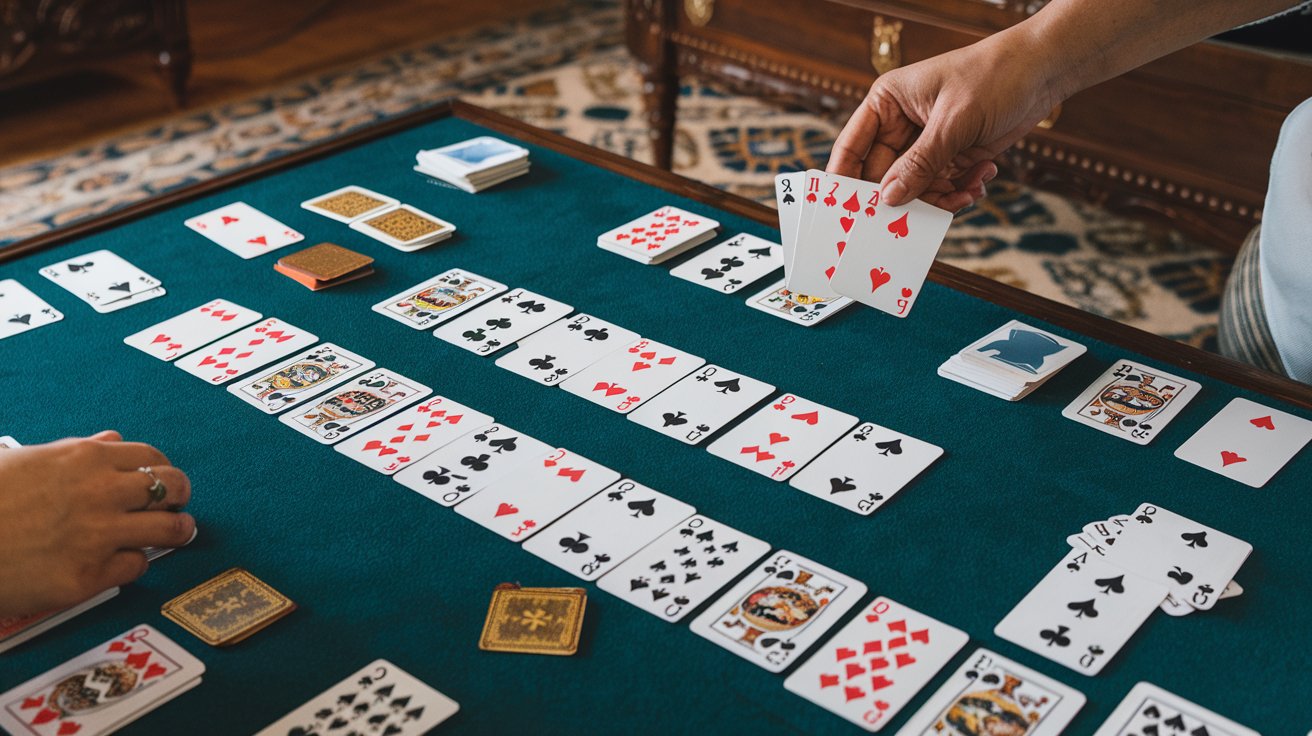Rummy isn’t just a game of luck—it’s a battle of strategy, intuition, and smart decision-making. One of the most underrated tactics in Rummy is strategic card holding. Knowing which cards to keep, when to hold them, and when to let them go can dramatically shift the game’s momentum in your favor. In this comprehensive guide, we’ll explore the art of strategic card holding, dive into advanced techniques, and show you how to use this tactic to outsmart your opponents and win at Rummy.
Introduction: The Art of Strategic Card Holding

Imagine having the ability to slow down time and foresee your opponent’s next move. While that might sound like a superpower, in Rummy, it all comes down to mastering strategic card holding. This technique isn’t about being overly conservative or risk-averse—it’s about making calculated decisions that maximize the potential of every card in your hand. Strategic card holding gives you the flexibility to form winning melds while minimizing the risk of inadvertently helping your opponents.
In this blog, we’ll take you step-by-step through the principles and practices that will help you harness the power of strategic card holding, ensuring you’re always one step ahead at the Rummy table.
SEO Keywords: win at Rummy, strategic card holding in Rummy, Rummy winning strategy, card holding tactics, advanced Rummy strategies
Understanding Rummy: The Fundamentals
Before diving into strategic card holding, it’s essential to have a solid grasp of the game’s basics:
-
Melds and Sequences: The core objective in Rummy is to form valid melds—either sets (cards of the same rank) or sequences (consecutive cards of the same suit). Successfully completing these melds is the pathway to victory.
-
Drawing and Discarding: Every turn in Rummy involves drawing a card from the deck or discard pile and then discarding one card. These decisions are pivotal, as they affect not only your hand but also the potential moves of your opponents.
-
Risk and Reward: Balancing risk with reward is inherent in every move. A risky play might yield a high reward if it leads to a quick win, but it can also backfire if it gives your opponent a valuable card.
Understanding these fundamentals lays the groundwork for more advanced strategies like strategic card holding. The real magic happens when you use your hand’s potential to build melds while simultaneously preventing your opponents from capitalizing on the cards you discard.
SEO Keywords: Rummy fundamentals, Rummy basics, Rummy rules, card game fundamentals
What is Strategic Card Holding?

Strategic card holding is the practice of carefully selecting which cards to keep in your hand and which to discard, based on both the current state of your hand and the evolving dynamics of the game. It involves:
-
Analyzing Card Potential: Determining which cards have the highest potential to form melds or sequences in future moves.
-
Balancing Flexibility and Commitment: Maintaining a flexible hand that can adapt to new cards while also being committed enough to form strong melds.
-
Timing Your Actions: Knowing when to hold onto a card for future potential and when to discard it to avoid helping your opponents.
In essence, strategic card holding is not just about the cards you possess but also about understanding the game’s flow and anticipating how your decisions will shape the match.
SEO Keywords: strategic card holding, card holding tactics, winning at Rummy, advanced Rummy techniques
Why Strategic Card Holding is Critical to Your Success
In Rummy, every card has a purpose, and how you manage your hand can make or break your game. Here’s why strategic card holding is so vital:
Maximizing Your Hand’s Potential
Every card in your hand should work toward your overall game plan. By holding onto cards that have multiple potential uses—such as cards that could fit into several possible sequences—you increase your chances of forming a winning meld. This flexibility means that as the game unfolds, you’re better prepared to capitalize on unexpected opportunities.
Minimizing Risks
Discarding the wrong card can sometimes hand your opponent the key they need to complete their meld. Strategic card holding involves analyzing the discard pile and predicting what your opponents might need. By holding onto or discarding cards wisely, you minimize the risk of inadvertently aiding your opponent.
Maintaining Control of the Game
A well-managed hand is like having a secret weapon. By strategically holding your cards, you control the pace and direction of the game. You can dictate when to push forward and when to play it safe, keeping your opponents on their toes.
Enhancing Flexibility
In a dynamic game like Rummy, the situation on the table can change rapidly. A flexible hand that has been honed through strategic card holding allows you to pivot quickly, adapting your strategy to the evolving game state without being locked into a single plan.
SEO Keywords: maximize hand potential, minimize risks in Rummy, control the game, flexible Rummy strategy
Key Principles of Strategic Card Holding

To master strategic card holding, you need to understand several core principles:
Flexibility and Potential
-
Versatile Cards: Always be on the lookout for cards that can serve multiple purposes. For instance, a card that fits into both a potential sequence and a set offers more opportunities than one with a singular role.
-
Anticipation: Think ahead about how your hand might develop. Consider various scenarios—what if you draw a specific card? How will it integrate with your existing cards?
Risk Management
-
Avoid Overcommitment: While it’s important to aim for strong melds, overcommitting to one strategy can leave you vulnerable. A balanced approach that keeps your options open is key.
-
Defensive Holding: Sometimes, holding a card isn’t just about building your own melds—it’s about preventing your opponents from getting the cards they need. For example, if you suspect an opponent is collecting a particular sequence, holding onto a crucial card in that sequence can disrupt their plan.
Disruption of Opponents’ Strategies
-
Observation: Keep a close eye on what your opponents are discarding and picking up. Their actions can provide clues about what they’re trying to build.
-
Calculated Discards: Sometimes, the best offensive move is a defensive discard. By strategically choosing which cards to discard (or not discard), you can interfere with your opponents’ plans while bolstering your own position.
SEO Keywords: Rummy flexibility, risk management in Rummy, defensive card holding, disrupt opponent strategy
Techniques to Master Strategic Card Holding
Now that you understand the principles behind strategic card holding, let’s explore some actionable techniques to put these ideas into practice.
Evaluating Your Hand at a Glance
Before making any move, take a moment to assess your hand. Ask yourself:
-
Which cards offer the most potential?
Look for cards that can easily merge with others to form sequences or sets. -
Which cards are dead weight?
Identify cards that don’t contribute to your current strategy or potential melds. -
What’s the overall composition of my hand?
Determine whether your hand is leaning towards one suit or is more balanced across multiple suits.
A quick but thorough evaluation will help you decide which cards to hold onto and which to consider discarding.
Grouping and Re-Grouping Your Cards
Strategic card holding is an ongoing process. As new cards are drawn and the game evolves, you should continuously re-assess and re-group your hand:
-
Initial Grouping: When you first receive your cards, organize them by suit and potential sequences. This visual arrangement makes it easier to spot opportunities.
-
Dynamic Adjustments: After each turn, re-group your cards based on the new information available. A card that seemed less useful at the beginning might suddenly become valuable.
-
Keep Options Open: Avoid locking yourself into a single grouping too early. Flexibility is key—be ready to shift gears if the game takes an unexpected turn.
Timing Your Discards and Holds
One of the most challenging aspects of Rummy is knowing exactly when to hold onto a card and when to discard it:
-
Early Game Strategy: In the initial stages, it’s often beneficial to hold a wide range of cards to keep your options open. Focus on gathering versatile cards that offer multiple possibilities.
-
Mid-Game Adjustments: As the game progresses and the discard pile reveals more information, start narrowing your focus. Identify the cards that are critical to your planned melds and protect them.
-
Late-Game Precision: In the final stages, every card counts. At this point, your decisions should be laser-focused on completing your melds while ensuring you don’t provide your opponent with a key card.
SEO Keywords: card grouping in Rummy, dynamic hand management, timing in Rummy, effective discarding
Advanced Strategies for Card Holding
Once you’ve mastered the basics, you can begin to implement more advanced techniques to take your game to the next level.
Predicting Future Draws and Opponent Behavior
A key component of strategic card holding is not just managing your own hand, but also anticipating what will happen next:
-
Card Counting: While keeping track of every card may not be feasible, having a rough idea of which cards have been played can inform your decisions.
-
Pattern Recognition: Over multiple games, you’ll start to notice patterns in how your opponents play. Use this insight to predict which cards they might be holding or discarding.
-
Scenario Planning: Always have a backup plan. Ask yourself, “What if I draw a certain card?” and plan accordingly. This forward-thinking approach ensures you’re never caught off guard.
Adjusting Your Strategy Mid-Game
No game of Rummy is static. As new cards enter the fray, you must be prepared to adjust your strategy:
-
Continuous Reassessment: After every move, take a moment to re-evaluate your hand in light of the new card distribution. Flexibility is key to maintaining an edge.
-
Switching Focus: If your original strategy isn’t coming together, don’t be afraid to pivot. Sometimes, shifting from an offensive to a defensive posture (or vice versa) can be the winning move.
-
Embrace Uncertainty: Understand that not every decision will be perfect. Learn from each game and adapt your strategy based on what works best in different scenarios.
Using Memory and Observation to Your Advantage
Your ability to remember which cards have been played—and to observe subtle cues from your opponents—can significantly enhance your strategic card holding:
-
Track the Discard Pile: Regularly scanning the discard pile can help you determine which cards are still in play. This information is vital for making informed decisions about which cards to hold or discard.
-
Observe Opponent Behavior: Pay close attention to the cards your opponents pick up or discard. Their choices can offer clues about their strategy, allowing you to adjust your card holding to counter their moves.
-
Review Past Games: Take time after each session to reflect on your decisions. Identify moments where strategic card holding made a difference and consider how you can improve further.
SEO Keywords: advanced Rummy strategy, predicting opponent moves, card counting in Rummy, memory and observation in Rummy
Practice Drills to Enhance Your Card Holding Skills
Like any advanced skill, strategic card holding improves with deliberate practice. Here are some drills to help you sharpen your abilities:
Simulated Game Scenarios
-
Focused Practice Sessions: Set up games where your primary goal is to experiment with different card holding techniques. This could involve playing against a computer or joining a friendly match with the aim of refining your strategy.
-
Role-Playing: Occasionally, try to play from your opponent’s perspective. Understanding how your moves appear to others can provide valuable insights into what cards are truly beneficial.
-
Timed Challenges: Use a timer to simulate the pressure of competitive play. This will help you learn to make quick yet effective decisions about which cards to hold.
Memory and Observation Exercises
-
Card Recall Drills: Practice remembering the order and suit of cards that have been played. Over time, this will enhance your ability to track cards in real games.
-
Pattern Recognition Games: Engage in activities or puzzles that challenge your brain to identify sequences and patterns quickly. The better you become at recognizing patterns, the more effectively you can plan your moves in Rummy.
-
Self-Review: After each game, spend a few minutes reviewing your decisions. Identify any moments where a different card holding strategy might have yielded a better outcome.
Mindfulness and Focus
-
Meditation Sessions: Incorporate short mindfulness exercises into your routine. A clear, focused mind is essential for keeping track of the game and making smart decisions.
-
Visualization Techniques: Before playing, visualize different scenarios where strategic card holding plays a key role. This mental rehearsal can prime your brain for quick, adaptive thinking during the game.
SEO Keywords: Rummy practice drills, improve card holding skills, memory exercises for Rummy, mindfulness in Rummy
Conclusion: Transform Your Rummy Game with Strategic Card Holding
Strategic card holding isn’t just a tactic—it’s a philosophy that transforms your approach to Rummy. By carefully selecting which cards to hold and when to let them go, you can unlock a new level of strategic depth in your game. This approach gives you the flexibility to form winning melds, minimizes the risk of helping your opponents, and keeps you in control of the game’s flow.

Zareb Saleh is a journalist at Gulf Today and a ghostwriter for Gameoholic, specializing in gaming, technology, and digital culture. With a keen eye for industry trends, he delivers insightful stories that engage and inform readers.




